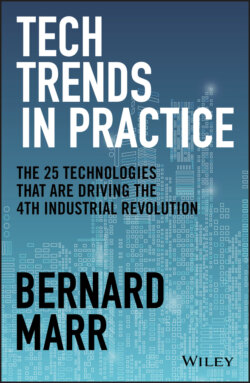Читать книгу Tech Trends in Practice - Бернард Марр, Bernard Marr - Страница 49
What Is Big Data and Augmented Analytics?
ОглавлениеLet’s start with the data itself, because data is critical to so many of the trends in this book, including artificial intelligence (AI, Trend 1), the Internet of Things (IoT, Trend 2), natural language processing (Trend 10), and facial recognition (Trend 12). Without data, the massive leaps we’ve seen in these trends – and many other technology trends – wouldn’t be possible.
At the heart of big data is the idea that the more data you have, the easier it is to gain new insights, and even predict what will happen in the future. By analyzing masses of data, it’s possible to spot patterns and relationships that were previously unknown. And when you can understand the relationships between data points, you can better predict future outcomes, and make smarter decisions on what to do next. It’s no exaggeration, then, to say that big data brings incredible opportunities to understand and change our world for the better.
But what is it that makes data, well, “big”? After all, data isn’t exactly a new thing. What’s new is the unprecedented digitization of our lives, where almost everything we do leaves a digital footprint. This is largely thanks to the rise of computers, smart phones, the internet, the IoT, sensors, and so on. Think of everyday activities like shopping online, reading the news in an app, paying for the morning coffee by card, messaging friends and family, taking and sharing photos, watching the latest show on Netflix, asking Siri a question, swiping right on a potential love match…we’re all generating data all the time.
The sheer volume of data that we’re creating, and the rate at which that volume is accelerating, is so vast that 90% of the data available in the world today was generated in the last two years.1 What’s more, every two years we’re doubling the amount of data we have available.2
How much data are we talking about? Well, we’re no longer talking about data in terms of gigabytes. These days, we’re talking about terabytes (just over 1,000 gigabytes), petabytes (a little over 1,000 terabytes), exabytes (roughly 1,000 petabytes), and zettabytes (approximately 1,000 exabytes). According to market intelligence company IDC, the amount of data in the world could grow from 33 zettabytes in 2018 to 175 zettabytes in 2025.3 To put that in perspective, if you stored 175 zettabytes on DVDs, you’d have a stack of DVDs so big it could encircle Earth 222 times! And the amount of data we’re generating is likely to accelerate further. In other words, big data is only going to get bigger.
Our ever-increasing digital footprint has also given rise to another interesting aspect of big data: the fact that there are many new types of data that can be analyzed. We’re no longer just working with numbers in spreadsheets, or entries in a database; today, “data” includes photo data, video data, conversation data (i.e. asking Alexa to play a certain song), activity data (such as browsing online or swiping left or right), and text data (like social media updates). Increasingly, the data we have to work with is unstructured, which means it can’t be easily classified into neat rows and columns, like in a spreadsheet. This unstructured data is more challenging to analyze – which is a major problem when you consider that data is pretty much useless unless we can find a way to extract meaningful insights from it.
This is where the augmented analytics part comes in. Handling masses of data can be an expensive, time-consuming, and highly specialized task. In other words, there are some serious barriers between the data itself and the ability to turn that data into actionable insights. Augmented analytics is about breaking down those barriers and making it easier to generate amazing insights from data.
In a nutshell, augmented analytics involves using AI and machine learning (see Trend 1) to automate analytics processes, including gathering data from raw data sources, preparing and cleaning that data, building unbiased analytics models, and generating and communicating insights to those who need them. What’s really exciting about this is it makes it easier for people to interact with data and extract the information they need, without the involvement of data specialists. So, in theory, with an augmented analytics tool, a non-tech expert could simply ask the system a question – like “Which of our employees are most likely to leave in the next 12 months?” – and the system would automatically generate a response.
Gartner predicts that by the end of this year, 40% of data science tasks will be automated,4 meaning augmented analytics is on track to become the leading analytics method of the future. As the trend really takes off, it’s likely we’ll see many more specialized augmented analytics apps and tools designed for specific industries in the future. This is good news for businesses, since augmented analytics provides a way for organizations of all shapes and sizes to handle the vast amounts of complex data they’re inundated with and give people in the organization easy access to analytics and insights from data. This wide access to data and insights is known as data democratization.
